If you’re looking to learn about RV boondocking for beginners, then you’ve come to the right place!
We love boondocking and sharing our knowledge and excitement with others! I know that many people don’t know much about boondocking, so I wanted to write this complete guide to RV boondocking for beginners.
I have a lot of information in this guide, but I hope this post is helpful and encourages you to try boondocking!
Alright, let’s jump into everything you need to know about boondocking in an RV!
This post may contain affiliate links. As an Amazon Associate, I earn from qualifying purchases. I may receive a small commission when you purchase using my links at no extra cost to you. Thank you for your support!
What is Boondocking?
If you are completely new to boondocking and what it is, I would like to explain it briefly. So, what is boondocking?
RV Boondocking
The word boondocking comes from the word boondocks, which refers to a rural or remote area. It is also referred to as dry camping and usually means that you are camping in a remote area with little to no amenities.
You usually don’t have hookups (which separates boondocking from developed campgrounds), and it is most often free campsites.

RV Moochdocking
You may have also heard of the term moochdocking. Moochdocking is similar to boondocking but is more commonly used to refer to parking on a friend’s or family’s land. We always moochdock when we visit my family’s farm in Illinois.
Moochdocking usually means you don’t have hookups either, but sometimes a family member will install electric hookups, and more often than not, water is available nearby.
I also consider staying in parking lots like Walmart and Cabela’s as moochdocking. We’ll talk more about this in a minute.
Now that you know what travel trailer boondocking is, let’s learn how to boondock in an RV.

How Can You Prepare for Boondocking?
You must be prepared before you go boondocking, especially if it is your first time. Here are a few things you can do to prepare.
Make Sure You Have the Essential Items For Boondocking
I wrote a blog post with essential Items for boondocking in an RV. You can check that out for the full list, details on each item, and camping gear you’ll need.
Make Sure You Have a Water Supply
We generally like to fill our water tanks before we head to a boondocking location. You can fill up your rig at an RV park (if you’re staying at one) or find somewhere to fill up.
City parks and truck stops have been good places to get water when needed. Just make sure that the water you’re getting is potable and safe. We have a 66-gallon tank on our 5th wheel that will last us for a while.
If you don’t want to fill your tanks in advance, you can use something to haul water. Our favorite thing to use for this is our water bladder, which holds roughly 30 gallons.
Have a Reliable Power Supply
We will go into more detail on this later, but you need a reliable power source. We have solar, Battleborn batteries, and a generator.
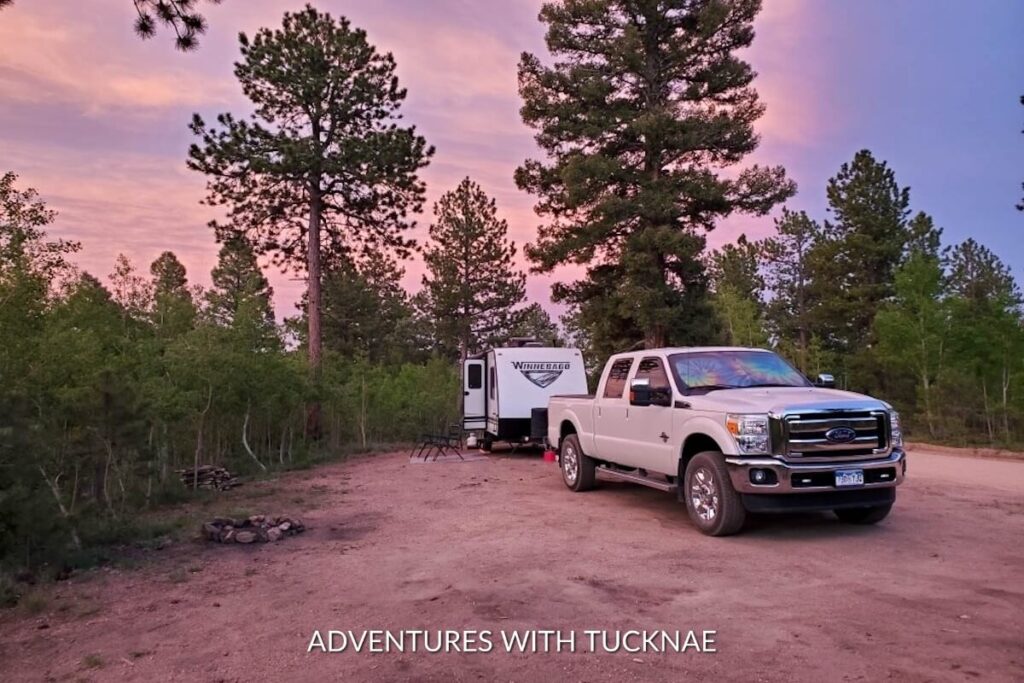
Stock Up On Food
One of my favorite off-grid camping tips is to stock up on food in advance. Boondocking locations are often remote and far away from towns.
We stock up on whatever food we need before reaching our boondocking location to have everything we need.
We have a large pantry that allows us to stock up on dry goods, and we stock our refrigerator and freezer before we leave.
Side note – you can read about how I organized our RV pantry here.
Prep Food in Advance
Not only do I like to stock up on food, but I also like to prep it. This saves water when we’re boondocking because we can wash fruits, veggies, and whatever dishes we use.
I like to wash and cut up vegetables and fruit, trim chicken or whatever meat we have, and sometimes even make meals in the fridge or freezer to easily pull out and cook.
I also ensure that all dishes are washed, but I do this before every travel day.

Scout Out the Boondocking Area In Advance
If you’re close enough to scout the area you plan to boondock in advance without your RV, that’s always best. We have been in tight situations when we didn’t scout in advance.
Reading reviews online helps, but there are sometimes things that you can’t foresee.
Popular boondocking sites can also fill up quickly, so it’s always best to have a backup plan in case there’s no room for you or it’s not a good fit.
Obviously, this isn’t always possible, but keep it in mind and check the area in advance when you’re able.
It’s also important to check your route as well.
Check the Weather
Check the weather for where you’ll be camping and ensure there won’t be any issues.
Most of the time, you are going to be parking on dirt or sand, and the last thing you want to happen is for you to get stuck!
If you are parking next to a river, you must be aware of possible flash floods during heavy rain and storms.
Be prepared. Have a plan for what to do in bad weather situations and discuss it with the whole family so everyone knows what to do in advance.
Catch Up on Laundry in Advance
Even if you have a washing machine in your rig, RV laundry uses lots of precious water. It also fills up your grey tanks quickly, so you want to avoid it when you can.
We like to stay at Passport America RV parks in between camper boondocking locations to do laundry, dump our tanks, and do a deep clean of the rig without worrying about water.
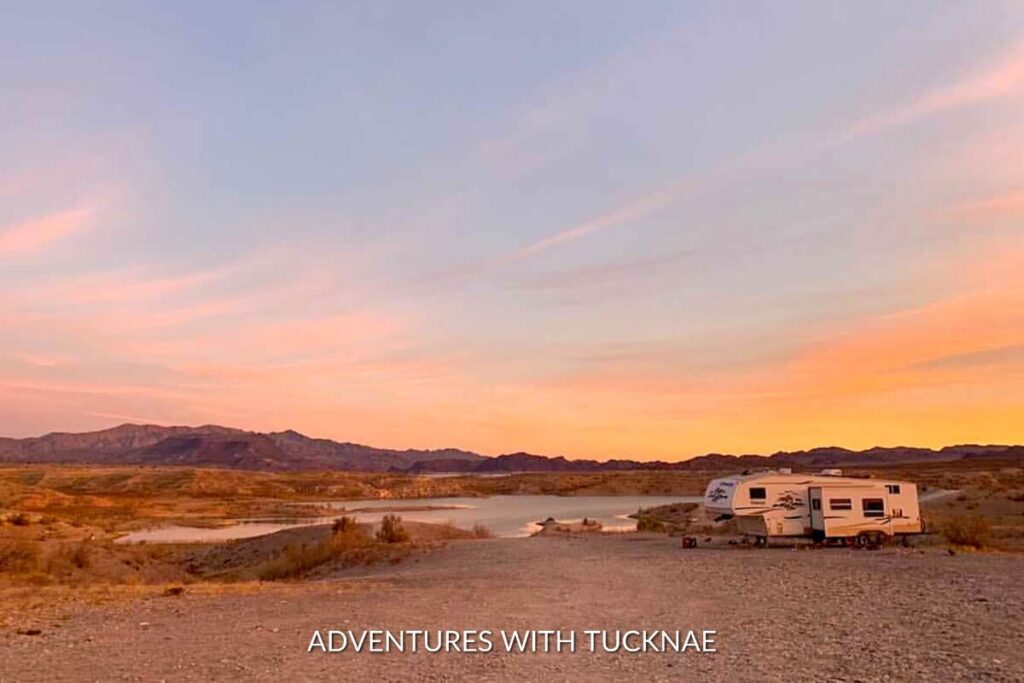
Check the Cell Service
Many digital nomads rely on cell phone service or the internet for work while boondock camping.
Check the coverage in the area where you plan to boondock and ensure that it’s strong enough for what you need.
Many leave reviews, including cell coverage for different carriers that can be helpful. We like to check the coverage on the Campendium boondocking app.
Many people also like to have a cell booster to help in areas where service is less than ideal.
We don’t personally have one, but many RVers we know to use and recommend the King booster.
Where can you go boondocking?
There are a lot of different places where boondock RVing is permitted. I will list some of the most common ones here.
Public Lands
Public lands are probably the most common and are our favorite locations for boondocking. They usually have dispersed camping.
Sometimes, sites will be large enough to hold several big rigs, and other sites are only big enough for van campers.
There is usually a 14-day limit for camping on public lands. Check the rules for the area you plan to stay in and don’t stay too long.
National Forest Service Land
Unless a sign says otherwise, you can usually camp anywhere on national forest land.
We recommend checking at the local ranger station to find out where primitive camping is and isn’t allowed. Sometimes, they will even have a boondocking map available for you to use.
Rangers are also usually able to point out the best spots and let you know what forest access roads are okay for the size of your rig.
You want to avoid getting stuck if you have a big rig!
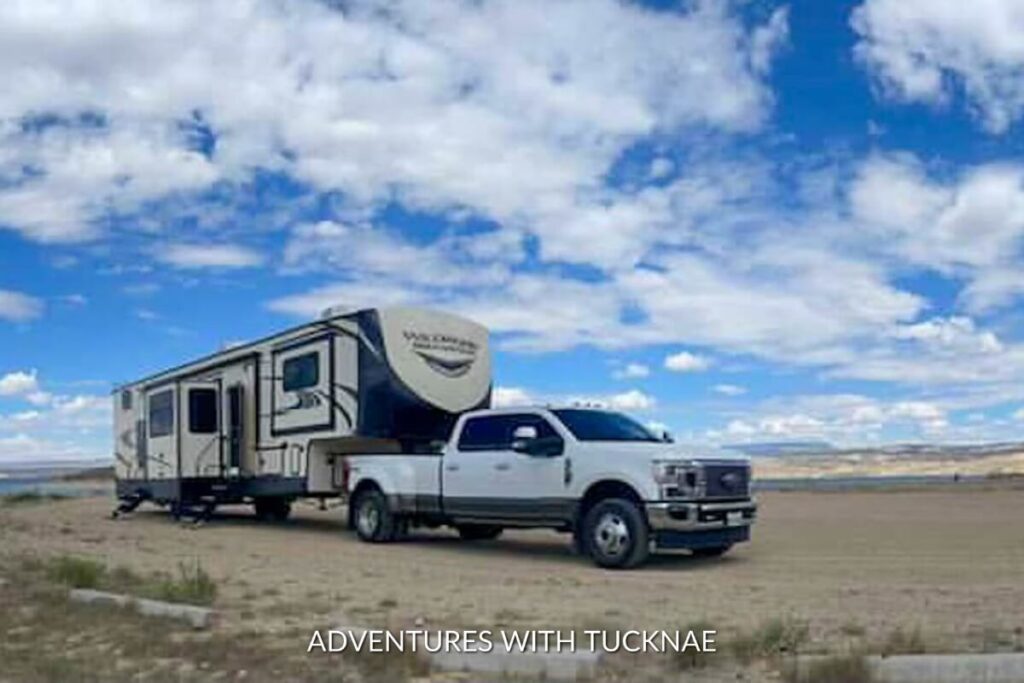
Bureau of Land Management (BLM) Land
BLM land is where we have probably done more boondocking than anywhere else.
These lands are most commonly found in the west, primarily in 12 states.
Alaska, Arizona, California, Colorado, Idaho, Montana, Nevada, New Mexico, Oregon, Utah, Washington, and Wyoming.
Wildlife Management Areas
Another great option is wildlife management areas. One of our favorite boondocking spots in New Mexico is Maxwell Wildlife Refuge.
Obviously, not all wildlife refuges are open to campers, so be sure to check before you go.
Boondocking Memberships
There are also boondocking memberships that you can join. These are sometimes more like moochdocking, but they’re great options anyway.
There are two that are the most common.
Harvest Hosts
I have many friends who use Harvest Hosts, and they are probably the most common boondocking for beginners membership. We have yet to try them, but we are planning to soon. There usually aren’t any amenities, but it’s a free and safe place to park, and there are some neat locations!
Harvest Hosts currently has over 2,500 locations across the United States. They are most commonly farms, wineries, museums, golf courses, etc., and allow you to stay for one night at each location unless the owner personally offers to stay longer.
A Harvest Hosts membership starts at $99/year without any discounts, but they offer discounts frequently. Staying at each location is free with your membership, but it is courteous to purchase something from the locations where you stay as a thank-you for allowing you to stay.
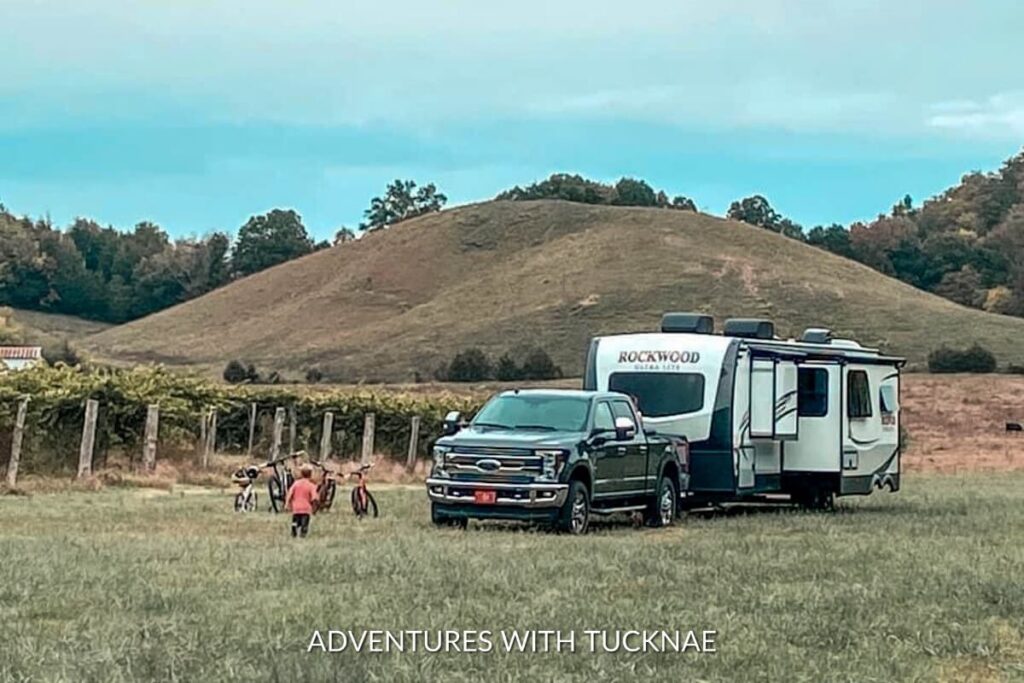
Boondockers Welcome
Boondockers Welcome is similar to Harvest Hosts, but it consists more of private property.
You aren’t guaranteed any amenities, but 3 out of 4 Boondockers Welcome hosts usually have water and electric hookups.
A membership to Boondockers Welcome costs $50/year. Once again, staying at each location is free with your membership.
If you use electricity, you are encouraged to leave a tip for your host, but it is not required.
Parking Lots
Chances are, you’ve seen someone boondocking at Walmart before! We’ve done it ourselves, although it’s not our preferred method of RV boondocking.
Always check with each store before you park for the night, but a few locations are usually welcoming to overnight parking.
- Walmart
- Truck stops
- Rest areas
- Cabela’s
- Bass Pro Shops
- Cracker Barrel
- Camping World
- Costco
- Sam’s Club
- Lowe’s
- Home Depot
As I already mentioned, get permission from each location in advance. I usually call and ask before we get there.
If a parking lot has “no overnight parking” signs posted, please follow them and find another place.
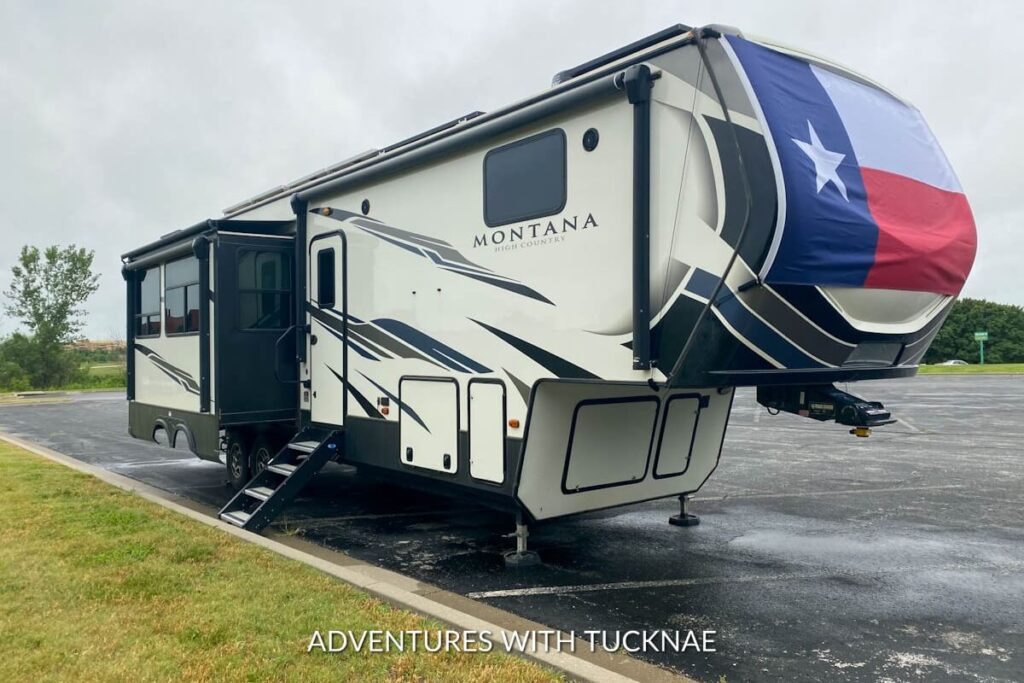
How Can You Find Boondocking Locations?
We get asked this question all the time, and no boondocking for beginners guide would be complete without answering it!
There are a few different ways to find boondocking locations.
The Campendium App
Hands down, our favorite RV boondocking app is Campendium! We use the Campendium app to find 80% of the places we stay. It’s our favorite app for boondocking beginners!
Thousands of free camping spots are listed on the app. It also shows RV parks and campgrounds, but you can use filters to view the free camping.
We love checking people’s reviews to find helpful information about each site. As mentioned above, reviews also let you know the cell coverage for each location. It currently mentions Verizon, AT&T, and T-Mobile.
It’s also helpful for obtaining other information like what amenities are offered (if any), activities to do in the area, if the location is big rig friendly, if pets are allowed, and if there are any facilities like trash bins or restrooms on-site.
Word of Mouth
One of my favorite ways to learn about new boondocking locations is by word of mouth!
Stop by a local ranger station; they can usually provide a map and show you the best spots to camp around them.
Asking other local RVers if they know of any good boondocking spots is a great idea, too.
Sometimes, they show you the best places that are less popular and overrun!

Facebook Groups
I’m leery of mentioning Facebook here because there are so many unkind people! But, being honest, it’s also a good place to find boondocking spots.
There are several boondocking groups on Facebook where people recommend locations and ask questions. Just be careful of all the crazies, haha!
I love asking for boondocking recommendations on Instagram! Sometimes, I will ask in a post, but more commonly, I do so in my Instagram stories.
If I have an IG friend who does a lot of boondocking, I will sometimes message them and ask if they have any recommendations for a particular area.
I have also received several messages like that myself, and I’m always happy to pass on locations when we have them!
How Do You Manage Not Having Hookups or Amenities While RV Boondocking?
This is what holds most people back from boondocking: the lack of comforting amenities. If you prepare in advance, it’s okay!
Managing Water
Obtaining Water
As I mentioned earlier, we usually start with filling our 66-gallon freshwater tank.
We haul water in our water bladder when needed and transfer it to our rig with a pump. Because we can haul water, it is our least concerning element when boondocking.
Filtering Water
You will want to always filter the water you put into your RV. We use our Clearsource Ultra to purify and clean our water in RV parks and while boondocking.
If you are near a river, lake, or similar water source, you can also use the Clearsource Nomad to filter and pump natural water into your rig!
Saving Water
I have another blog post about how to save water while boondocking, but here are a few small tips.
- Use a water-saving showerhead.
- Use wet wipes in between showers.
- Rinse and wash dishes immediately to prevent food from getting stuck and needing more water.
- Use disposable plates, bowls, and eating utensils.
Managing Power
An important part of boondocking for beginners is considering your power needs before heading out.
There are usually three main components to consider concerning boondocking and power.
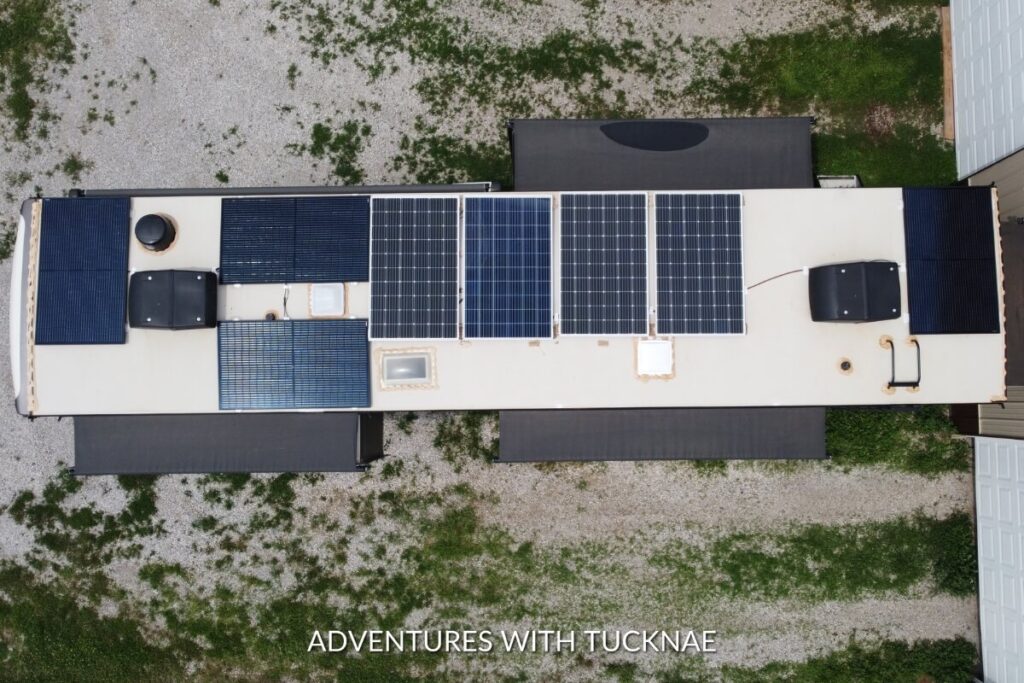
RV Solar
We have eight solar panels on the roof of our boondocking RV (which you can read about here), which equals a total of 2,320 watts of power. Read our detailed blog post about our complete solar setup here.
RV Batteries
Most RVs come with cheap deep-cycle RV batteries from the factory. These are okay if you’re planning to stay at RV parks all the time, but if you want to boondock a lot, you should consider upgrading.
They aren’t a cheap upgrade, but we recommend Battleborn batteries, which are high-quality LiFePO4 lithium batteries. We added 4 of these to our rig and plan to add 2-4 more.
RV Generator
Most boondockers carry a generator to recharge their batteries when needed or have backup power. We use ours when it’s been raining for several days or overcast, and our solar isn’t picking up enough sun.
You can use whatever generator you choose, but we use the Honda EU3000IS generator.
Managing Tanks
Our holding tanks are our biggest concern and what we are most conscious about when boondocking.
Your black and grey tanks can fill up quickly if you’re not careful!
Finding Places to Dump Tanks
Once again, we use the Campendium app for this. You can set the filters to show you nearby dump stations.
Usually, these are at rest stops, gas stations, and roadside parks. We have also just waited and dumped our tanks at the next RV park.
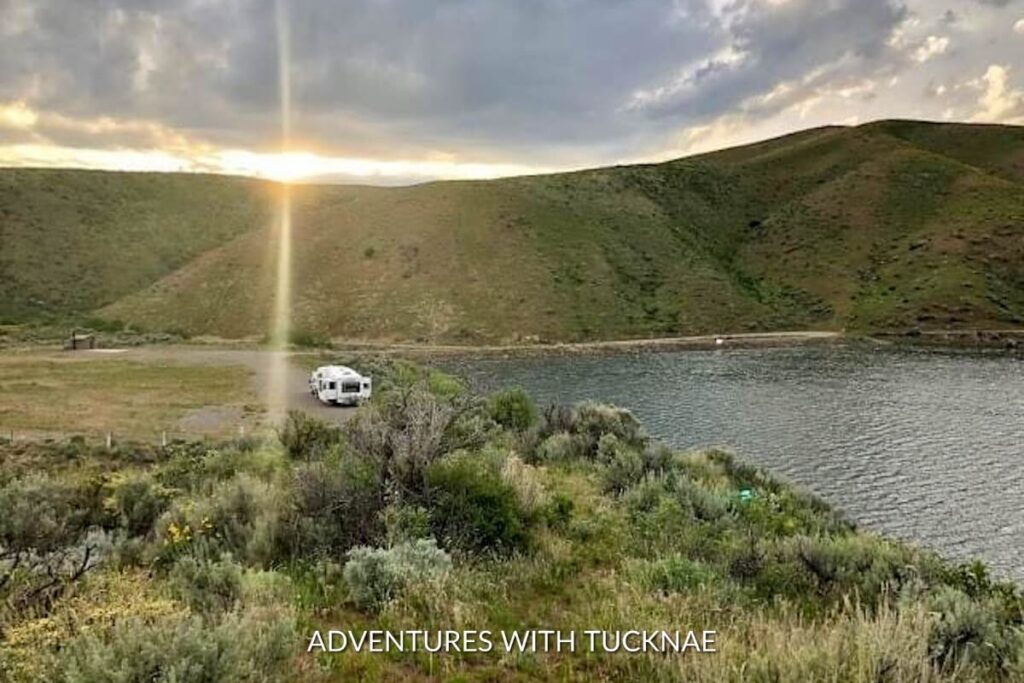
Be Careful What You Allow to Go Down the Drain
If you’re worried about your black tank filling up too fast, consider putting your used toilet paper in a trash bin instead of in the tank.
This will save some room, and you won’t need to flush as much water to break up the toilet paper as you usually would.
Some people use portable outdoor showers to keep that water from ending up in their grey tanks. We aren’t that extreme, but it is an option.
You could also stand in a bucket in the shower to catch some of the extra water. Some people even use that water to flush their toilets.
I also like to wash dishes in my collapsible dish bucket. When I’m finished, whatever water is left in the bucket can easily be dumped outside.
What About Boondocking With Pets?
Our two dogs love boondocking with us! They generally have more freedom when we’re boondocking than at an RV park because there aren’t as many rules for them.
Off-Leash Dogs
As long as there are no rules against it, we generally allow our dogs to be off-leash when other campers aren’t nearby. They love playing fetch and running to get the zoomies out!
You can do the same if your dog is well-behaved and won’t run off. Consider leashing your dog if a family with children is camping close by.
Just because your dog is friendly doesn’t mean that the kids won’t be scared of them.
Be Mindful of Extreme Temperatures
If you’re boondocking in either extremely hot or cold temperatures, be extra mindful of your pet and its needs. If it’s very hot, ensure they can access all the water they want. We even sometimes like to give our dogs an ice cube to play with.
Don’t leave your pets alone in your RV for very long, and be mindful when you do. Many National Parks don’t allow dogs, so we try to explore those early in the day before it gets too hot for the dogs to be left alone.
Considering getting a dog in your RV? Check out this post with tips for raising a puppy in an RV.
Is Boondocking Safe?
Generally speaking, yes. We have only had one time when we felt unsafe due to some teenagers messing around in the middle of the night.
Here are some RV safety tips for boondocking.
Don’t Stay in an Unsafe Area
This one seems common sense, but if an area feels unsafe, stay elsewhere.
This is another reason we like to read reviews…if someone feels unsafe in an area, they will generally leave a review about it.
Use your best judgment.
Keep Your Doors Locked
Sometimes, being alone in nature feels peaceful and safe, but it’s still best to lock your doors.
We upgraded our locks to Latch.It RV keyless entry locks, which give me even more peace of mind.
Remember to lock your cargo bay area and secure bikes at night. We have friends whose bikes were stolen overnight. You can never be too careful!
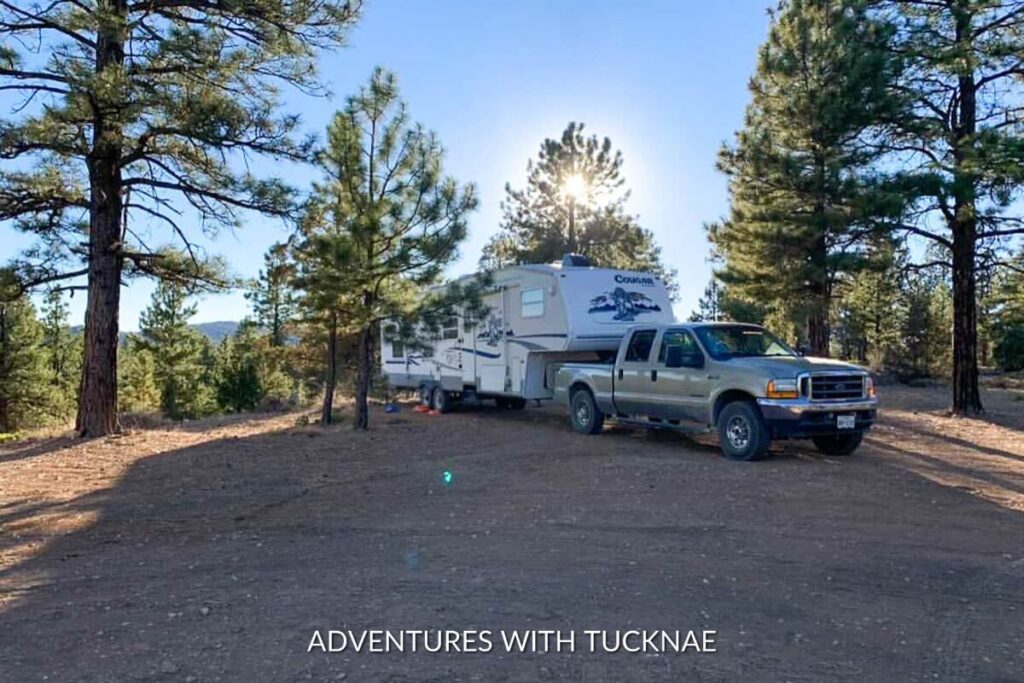
Keep Food Locked Away from Animals
Depending on where you’re at, wildlife can be a concern. Bears and other wild animals can search for food, especially at night. Make sure to lock up any food in an area that might attract wild animals.
Have Some Form of Protection
This is obviously up to you and what you are most comfortable having with you. Research different protection options and decide what’s best for you.
Stay in an Area with Cell Service
Cell service will be vital if you have a problem and need to make a call.
Sometimes, we choose to stay somewhere without cell service for a weekend or so, but we always make a backup plan in case something goes wrong.
Keep an Emergency First-Aid Kit
If you are staying in a more remote area, getting help during an emergency can take a while.
Always keep a good first aid kit to treat minor injuries as needed.
What is Proper Boondocking Etiquette?
There are a few things to remember and follow to help improve the boondocking experience for yourself and those camping around you.
Take Your Trash
Nothing can ruin a boondocking spot faster than a ton of trash lying around. No one enjoys it, so don’t do it!
Be sure to take everything out that you brought in.
Please don’t just throw your trash in a fire pit. We often see empty cans, broken glass, and wires in fire pits.
When you do that, it just means that the people camping there next will have to clean up after you. Please be considerate!

Be Responsible with Campfires
Don’t be responsible for starting a wildfire! Please always check the local conditions and ensure there isn’t a fire ban before lighting a campfire or using a grill.
If you start a campfire, ensure it is 100% out before stepping away.
Sadly, many wildfires are started yearly by people ignoring fire bans or leaving their campfires before they’re completely out.
Please don’t let this happen because of you!
Don’t Be Destructive
Again, this should be common sense, but please don’t be destructive. Don’t chop down trees or pick wildflowers.
Please stay on the main roads, and don’t go off-road unless signs state that it is allowed.
Be Considerate of Other Campers – Especially at Night
No one likes noisy campers at night, haha! Be mindful of how late you run your generator.
Don’t be loud at night if you have neighbors close to you. This is especially frustrating for those with small kids trying to sleep.
Other Boondocking Tips for Beginners
Here are a few final tips for you to consider.
Don’t Arrive After Dark
This one is really important! There’s nothing quite as stressful as trying to set up camp in the dark, especially when you’re boondocking.
You should arrive during daylight for your safety so you can see your surroundings and avoid dangerous situations.
If you are too far away to make it before dark, consider stopping somewhere along the route and finishing the trip the next day.
I can’t stress this enough, but please take my word for it!

How to Get a Spot at a Popular Boondocking Location
Some locations are definitely more popular than others. Weekends usually fill up faster; sometimes, finding a parking place can be impossible!
Our best tip for avoiding this is to get to a popular location mid-morning on a weekday.
This is usually when most people leave, and you’ll have the best chance of snagging an open spot.
You can also ask people if they will allow you to share their spot if you feel comfortable doing so and there’s enough room for two rigs.
In Closing: A Complete Guide to Boondocking for Beginners
What RV boondocking tips or boondocking hacks would you add to my list? Feel free to drop them below!
Learn More About RV Boondocking:
- A Complete Guide to Boondocking for Beginners (2024)
- 15 Helpful Tips for Saving Water While Boondocking
- Our RV Solar Setup
- Top 45+ Must-Have RV Boondocking Essentials for Dry Camping
- 9 of Our Favorite Boondocking Locations
- 8 Helpful Apps for Boondocking
- Boondocking Review: Maxwell Wildlife Refuge, Maxwell, NM
I hope you found this guide to boondocking for beginners helpful! If you have any additional questions, comment below or email me.
Happy boondocking!


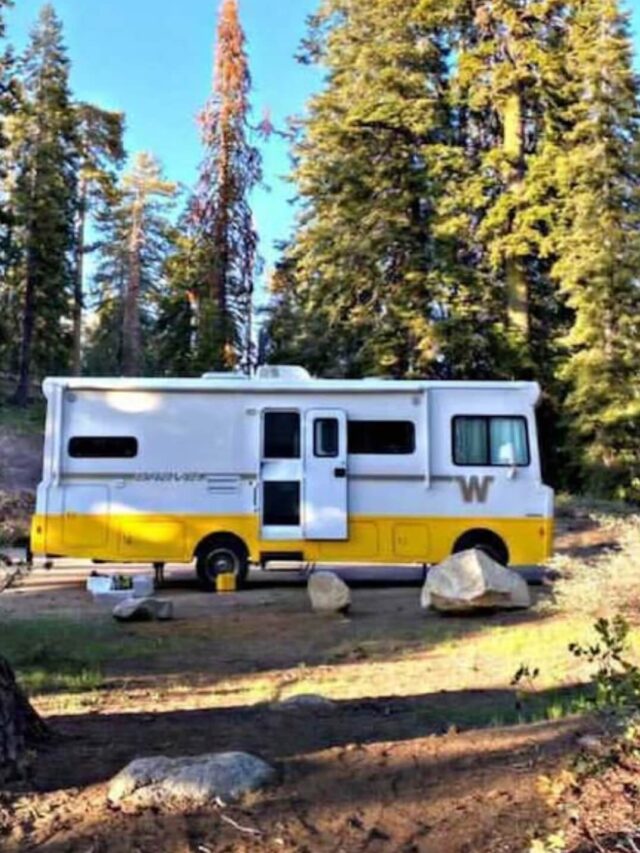

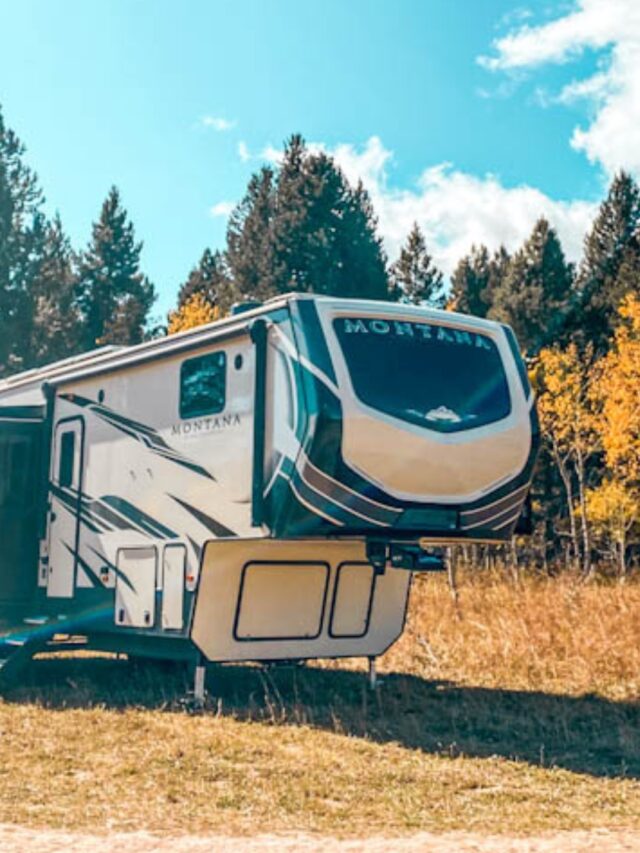
Wow!! This is chalked full of good information. Thanks for sharing. Will definitely be saving this blog 👏🏼👏🏼
What an extensive post!! Perfect for those just jumping into boondocking and even things seasoned vets can learn from. We have always wanted to sign up for harvest hosts, but we aren’t able to do it very often so haven’t yet. Mostly do BLM or Cracker Barrel, but we have called a few wineries/breweries in advance to see if they might let us stay overnight so we don’t have to worry about overserving ourselves. Great tips!! Thank you!
I’m so glad you enjoyed it! Thank you Melanie! 😊